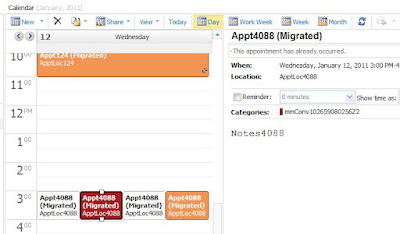
Migrates to Exchange like this:
 Tasks come over with very few problems. What in Zimbra looks like this
Tasks come over with very few problems. What in Zimbra looks like this
Sumatra Development leads the field of migrating entire calendar servers to Exchange. We migrate Oracle Calendar Server, Oracle Beehive, Apple iCalendar, and Zimbra to Microsoft Exchange keeping all meeting information and resource bookings intact. We migrate calendars server-to-server between Exchange and Office 365 while keeping meetings live and doing incremental syncs quicker than any other solution.

 Tasks come over with very few problems. What in Zimbra looks like this
Tasks come over with very few problems. What in Zimbra looks like this




Live@EDU | On-Premises |
| ||||
Object Count | 7675 | 7585 |
| |||
Total Time (seconds) | 4193.25 | 597.01 |
| |||
Total Time (minutes) | 69.89 | 9.95 |
| |||
Average Insertion time | 0.55 | 0.08 |
| |||
Mode | 0.41 | 0.05 |
| |||
Median | 0.44 | 0.05 |
| |||
Max | 9.29 | 3.5 |
| |||
Min | 0.10 | 0.03 |
|
So our latest tests on inserting calendar items into Live@Edu vs. inserting into on-premises Exchange gives us a 7:1 time ratio.
That is: it is currently about seven times faster to migrate calendar data into your own Exchange server than it is to migrate it to Live@Edu. We've seen the same data set go far longer, but this is a good estimate to use in your planning purposes. Also yesterday another real-world site reported a figure similar to the one we found.
Just so you know.
In this example we kept inserting meetings until we hit quota. So one went in fine (you see the guest list and responses) and one did NOT (it says "Invitations haven't been sent for this meeting").
Once your submission quota rolls over (and when is that exactly?) you can send this and it'll go out like a regular meeting invitation. Not fatal in a migration, but we agree, it is darned annoying.

If your head does not hurt you have not been paying attention.
SO, for the time being while running a holiday insertion with our tools, specify Exchange 2007 SP1. Everything will be hunky-dory.
Don't believe us? Here's the VB .net code (we use Exchange Web Services Managed API v1.1. )
Public Function ewsBuildAllDayEvent() As String
Try
Dim myUserEmail As String = "user10@test.com"
Dim myEWSURL As String = "https://sn1prd0202.outlook.com/EWS/Exchange.asmx"
Dim myExchangeVersion As ExchangeVersion = ExchangeVersion.Exchange2007_SP1
Dim myLogon As String = "admin@test.com"
Dim myPassword As String = "Gu3ssWh0"
'create Service
service = New ExchangeService(myExchangeVersion)
service.Url() = New Uri(myEWSURL)
service.Credentials = New WebCredentials(myLogon, myPassword)
service.ImpersonatedUserId = New ImpersonatedUserId(ConnectingIdType.SmtpAddress, myUserEmail)
'build appointment
Dim appointment = New Microsoft.Exchange.WebServices.Data.Appointment(service)
appointment.subject = "MyTestADE"
appointment.Start = CDate(Now.ToShortDateString)
appointment.End = CDate(DateAdd(DateInterval.Day, 1, Now))
If myExchangeVersion = ExchangeVersion.Exchange2007_SP1 Then
appointment.StartTimeZone = System.TimeZoneInfo.FindSystemTimeZoneById("Eastern Standard Time")
Else
appointment.StartTimeZone = System.TimeZoneInfo.FindSystemTimeZoneById("Eastern Standard Time")
appointment.EndTimeZone = System.TimeZoneInfo.FindSystemTimeZoneById("Eastern Standard Time")
End If
appointment.LegacyFreeBusyStatus = LegacyFreeBusyStatus.Busy
appointment.isalldayevent = True
appointment.Save(SendInvitationsMode.SendToNone)
Return "OK"Catch ex As Exception
Return ("ERROR: " & ex.Message)
End TryEnd Function

 A few other things to keep in mind.
A few other things to keep in mind.If Oracle Calendar Server IDs are DIFFERENT from Exchange:
Once you've got all your users mapped you can just edit the mapping table. But please exercise proper handling and care with it. You do not want to be wondering which version to use when starting yoru migration at midnight on a Friday.

 While this is an appointment we've put into every calendar without any muss or fuss. You could use the same technology to do that for anything else you want (Shareholder's Meetings, Fire Drills, as your business and imagination dictate).
While this is an appointment we've put into every calendar without any muss or fuss. You could use the same technology to do that for anything else you want (Shareholder's Meetings, Fire Drills, as your business and imagination dictate).

Put all resources in one or more OUs for ease of administration.
PRIOR to migration:
AFTER the migration

Create a managementRoleAssignment:
new-ManagementRoleAssignment
-Name:_suImp8
-Role:ApplicationImpersonation
-User:'mysvcaccount@mydomain.com'
If you have to ask where you're doing this, please go to your Exchange Administrator.
So -- when doing a migration of about any non-trivial size into 2010 you're going to have to set a new throttling policy here called "SuPolicy":
New-ThrottlingPolicy SuPolicy
Set-ThrottlingPolicy SuPolicy -RCAMaxConcurrency $null
-RCAPercentTimeInAD $null
-RCAPercentTimeInCAS $null
-RCAPercentTimeInMailboxRPC $null
-EWSMaxConcurrency $null
-EWSPercentTimeInAD $null
-EWSPercentTimeInCAS $null
-EWSPercentTimeInMailboxRPC $null
-EWSMaxSubscriptions $null
-EWSFastSearchTimeoutInSeconds $null
-EWSFindCountLimit $null
Set-Mailbox myserviceaccount@mydomain.com -ThrottlingPolicy SuPolicy